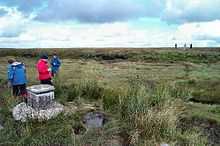Cranmere Pool

Cranmere Pool is a small depression in the peat in the northern half of Dartmoor, Devon, England, at grid reference SX604858. It lies about 560 metres above sea level on the eastern flank of Hangingstone Hill, close to the source of the West Okement River, about 0.5 km north west of the source of the East Dart River, and about the same distance west of the River Taw's source.[1]
It lies within the Okehampton Artillery range, one of the Ministry of Defence ranges. A military access road which made it possible to drive to within one kilometre of the pool was closed for civilian use in 2010.
Cranmere Pool was once a permanent pool of water, but William Crossing, writing early in the 20th century, stated that it had been over a hundred years since this had been the case.[2] The only time there is standing water today is after heavy rainfall.
Cranmere Pool is the location of the first letterbox. William Crossing relates in his Guide to Dartmoor that James Perrott, a well-known Dartmoor guide from Chagford, built a cairn in the pool and placed a bottle there for visitors' cards in 1854.[2]
In Ernest George Henham's novel A Pixy in Petticoats (London: Alston Rivers Limited, 1906), Cranmere Pool and its famous letterbox play a vital part in the plot. It is a story of unrequited love between Beatrice Pentreath and John Burrough that occurs primarily in Dartmoor.
Legends
Cranmere Pool is at the heart of several Dartmoor legends, the most common of which involve the former mayor of Okehampton, Benjamin Gayer or Gear who was actually mayor of the town five times during the 17th century and has a memorial in Okehampton church vestry.[3]
In one version of the legend "Benjie Gear" was convicted of stealing sheep and as punishment was ordered to empty Cranmere Pool with a sieve. Being a resourceful person, he stole and killed another sheep and lined the sieve with its skin which allowed him to empty the pool so quickly that the town of Okehampton, in the valley below, was flooded. For this misdemeanour he was hanged on nearby Hangingstone Hill and his spirit was condemned to spin all the sand at the bottom of the now-empty pool into ropes. And since he has been unable to find any way of doing this, he is still there and can be heard on dark nights moaning and wailing about his never-ending task.[4]
References
- ↑ Ordnance Survey 1:25,000 map OL28
- ↑ 2.0 2.1 Crossing, William (1976) [1912]. Crossing's Guide to Dartmoor (Reprint ed.). Newton Abbot: David & Charles. pp. 479–80. ISBN 0-7153-4034-4.
- ↑ St. Leger-Gordon, Ruth E. (2001 [1965]). The Witchcraft and Folklore of Dartmoor (Reprint ed.). Newton Abbot: Peninsula Press. p. 51. ISBN 1 872640 11 7.
- ↑ Various versions of this legend exist. See for example:
- Barber, Sally and Chips (1988). Dark and Dastardly Dartmoor. Exeter: Obelisk Publications. pp. 10–12. ISBN 0 946651 26 4.
- Pegg, John (1987). After Dark on Dartmoor (4th ed.). Tunbridge Wells: John Pegg. pp. 13–14. ISBN 0 9508598 1 8.
- Sandles, Tim. "Cranmere Pool". Legendary Dartmoor. Retrieved 2012-09-16.
Coordinates: 50°39′18″N 3°58′34″W / 50.65510°N 3.97624°W